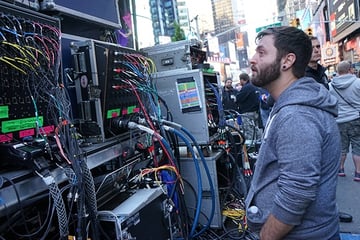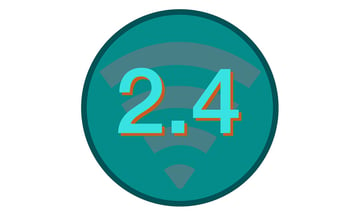- Products
- All Products
- RF PA Extension Kit
- Wireless Microphone Upgrade Packs
- In-Ear Monitor Upgrade Packs
- Wireless Microphone Antennas
- Wireless In-Ear Monitor Antennas
- Antenna Distribution for Microphones
- Antenna Combiners for In-Ear Monitors
- Multi-Zone Antenna Combiners
- Spectrum Tools
- Accessories, Cables and Parts
- Solutions by Venue
- Resources & Training
- Performance Tools
- About Us

Setting up a wireless audio system in a new venue can be a challenging undertaking.
It begins the moment you get the call from the client and only ends once the system is performing as expected post-install. It requires more than just technical abilities.
You have to know how to collaborate with the client, create an equipment and frequency band plan, juggle project costs, execute that plan, manage a team, and make sure your system runs as specified.
Clients come in all levels of sophistication as well. Some know exactly what they want, down to technical specifications and documented frequency coordination plans. Others have existing equipment they want you to use. And some just say “No idea - just need some mics?” As a system integrator, you have to be able to balance these factors and create a project that satisfies the client and your bottom line.
Determining the scope and who is involved
The first time you visit the site and meet the venue owner or event organizer is the most critical part of the wireless audio installation process. Through this meeting, you’ll evaluate the site and lay out the scope of the project. No matter how well the venue owner describes the space, there’s no substitute to seeing it for yourself and mapping out an initial concept design.
This is also an opportunity to explore any frustrations the client has had in the past with wireless that you may focus on solving to really deliver the greatest value. It’s also important to assess who the stakeholders are on the project. Often times we see separate business stakeholders and technical stakeholders who may have different priorities that need to be addressed.
The details of your project will of course depend on the number of wireless audio channels needed, and the size and type of events hosted in the venue. Before you start going through the details of the project with the customer, it’s good to first check with them to see if they are hiring any other teams to work on the venue or at the event.
In many cases, clients are unaware how other aspects of an integration project will affect the wireless system. You don’t want to show up on installation day to discover another team whose plan conflicts with yours or with an entirely different venue configuration.
Here are some instances I’ve seen where there was conflict because installation teams didn’t work together or even know about one another.
- Set designers eliminate line of sight by installing a wall directly between an antenna position and the operating area. Well hello, laws of physics.
- LED video walls introducing stray RF energy to the operating area, reducing range and potentially causing interference or signal dropouts. [Additional tips on dealing with video walls here]
- News organizations or other third party audio, video, or communications teams bring in their own wireless without coordinating frequencies. This is a major factor on large scale events. Full time RF coordinators spend a lot of time simply tracking down and policing rogue transmitters in the venue.
Best practices for running a smooth wireless audio installation
How do you make a wireless audio installation successful?
Step 1: Work with client to create a solid installation plan
Ideally, this should happen face-to-face. You should make a site visit anyway to evaluate the space, so this is a good time to start piecing together a comprehensive project plan. During this conversation, get a clear understanding of the customer’s goals. You want the venue owner or event organizer to feel like you are adding value to their effort, not just looking to take their money and move on to the next project.
This is your opportunity to clearly demonstrate your expertise and earn trust. The first step to take is to visualize the RF spectrum in the facility and walk the client through it, introducing them to baseline conditions and your plan to coordinate their system for best performance.
Keep in mind that staying up to date on FCC or your local regulatory environment and teaching the client some basics about the dynamic nature of RF spectrum can put you ahead of competitors doing drive-by install work, as well as take some of the “black magic” out of wireless systems for the client.
The end result of this meeting should be at minimum a ballpark budget for the system and install work as well as an idea of how many channels will need to be configured into the wireless audio system.
Step 2: Manage your client’s expectations
Customers who don’t have much experience with wireless installations often have unreasonable expectations about the performance of the system. For instance, if you setup a wireless system indoors, you may be surprised to get a call several weeks later from an angry customer expecting their microphones to work outside or in the front lobby or on the second floor, even though they never requested that upfront.
For the sake of your reputation, don’t greenlight everything the customer asks. If something isn’t doable, speak up. Don’t over promise results that can’t be obtained by the equipment within their budget. I find we often need to gently walk back the requirement for the “the wireless mics need to work everywhere, always” and more often than not discover that 90% of the required performance is within a manageable (fixed) operating area.
Step 3: Understand operation area and scan, scan, and scan again
In order to produce the best sound without interference or dropouts, you need to understand the layout of the space and how the wireless mics, IEMs, or communications equipment will be moving around. What is the operating area of the system? Where will the performers be located? Where will the audience sit or stand? Are there known sources of interference within the venue or other wireless systems operating that need to be coordinated?
Once you’ve evaluated the site and understand your customer’s goals and budget, you’ll be able to determine what types of equipment you need, and where it should ideally be positioned.
Most importantly, you need to run an RF spectrum analysis to identify any sources of interference and establish a baseline for RF conditions in the venue over a period of time. This will provide you and the client with a clear understanding of what the RF environment looks like pre-install, and then post-install you can provide detailed scan data to show how the system is configured. This can save enormous headaches in the future when additional channels are added without proper coordination, or the baseline environment changes and a paid service call will be required to reset everything.
Step 4: Control the costs of your wireless audio installation
You want to produce a fantastic experience for your customer and their audiences, but at the end of the day you’re a business that needs to make money. Controlling your costs and ensuring you make a profit can be achieved by following three pieces of advice.
- Understand the job in detail so you can give the customer an accurate quote.
- Make arrangements with manufacturers or distributors so you’re getting the best possible pricing for the job.
- Reduce your labor costs as much as possible by planning ahead or pre-configuring systems during downtime at your own facility.
- Closely consider remote antenna cable runs and factor those in your estimate if they may be required.
Step 5: Use frequency coordination software. Everytime.
When it comes time to actually install the system for the space and set your frequencies, you should follow your carefully laid band plan, even if it’s a small job. Rehearse if you can. You must relentlessly test, test, test your entire setup.
Software applications like Shure Wireless Workbench, IAS, and Sennheiser Wireless System Manager, or our own Vantage mac OSX software in combination with those tools can be the difference between success and failure.
If you only set up your mic frequencies based on an onboard receiver frequency scan tool, you are potentially missing interference sources in the venue that those receivers can’t scan. A spectrum analyzer or wideband scan is especially crucial in congested RF environments. Best practice is to tap off of a spare output or cascade port on an antenna distributor to see exactly what your wireless receivers are seeing down the signal path.
“War-gaming” your transmitter frequencies is also highly recommended to root out any IMD problems. We have a walkthrough video of that process here if you’d like to learn more.
Step 6: Be prepared for the inevitable problems
No two wireless integrations are the same and most of them deal with a mild hiccup. The trick is to be prepared for the most common challenges.
For instance, you might arrive at the event space and discover via your spectrum analysis that an unknown third party is using the RF range you intended to occupy. Or you might realize that when the venue is filled, the noise floor is higher than previously seen or the RF propagation in the room is completely different, causing limited range or signal level. These could be devastating, labor-intensive problems if you aren’t ready to address them.
Step 7: Stay sharp during a wireless audio event
If you’re running the audio during an event, the day can be hectic. You’ll have to deal with the event organizer and rely on your team to do their jobs.
Again, you should be running repeated tests and analyzing the area’s RF spectrum to make sure your system will work. A real-time RF monitoring view can be a lifesaver to identify frequencies that are dropping out or causing interference problems.
Smooth installations lead to big business growth
Venue owners and event organizers are busy people with a lot to juggle. They are always looking for talented vendors and technicians who can take work off their plate and don’t need to be micromanaged. If you can position yourself as a company that runs a smooth wireless audio installation, future work will come your way.
The best wireless performance comes from the best equipment. Check out our selection of antennas, distribution equipment and spectrum analysis software that work with all brands of wireless mics, IEMs, and other production communications gear.
We also work with hundreds of system integrators in the US and more around the world. Contact us today to become an authorized RF Venue dealer and reduce your wireless project costs and complexity.
Tag(s):
Case Studies
Alex Milne
Alex Milne was Product Marketing Manager and Digital Marketing Manager for RF Venue, and a writer for the RF Venue Blog, from 2014-2017. He is founder and CEO of Terraband, Inc., a networking and ICT infrastructure company based in Brooklyn, NY., and blogs on spectrum management, and other topics where technology,...
More from the blog

2.4 GHz CP Beam
RF Venue Antennas Support Times Square Musical Festival
1 min read
| December 15, 2014
Read More

Knowledge Guides
UK OFCOM Agency Publishes Study on WSD/TVBD Interference to Wireless Microphones
4 min read
| January 14, 2015
Read More

2.4 GHz CP Beam
Everything You Need to Know about 2.4 GHz Wireless Microphones
5 min read
| January 27, 2015
Read More
Subscribe to email updates
Stay up-to-date on what's happening at this blog and get additional content about the benefits of subscribing.

